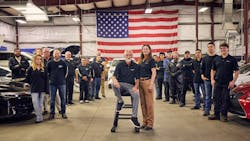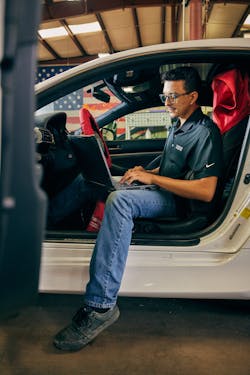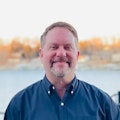The increased demand for equipment and know-how needed to repair an ever-increasingly complex vehicle parc is undeniable. The two single-location shop owners FenderBender interviewed for this article face many of the same issues as do the more than 300 respondents to the 2023 FenderBender Industry Survey, including staffing shortages and the training and equipment needed to repair the latest technology. These two shop owners have approached the problem with some common methods and some notable differences.
One trend, a move away from direct repair programs (DRPs), has remained constant throughout the history of the survey. The number of shops reporting no revenue from DRPs in 2018 was 30%, and five short years later, that number is up to 44%. Both Rob Grieve, who owns Nylund’s Collision Center with his wife, Carol, in the Denver suburb of Englewood, Colorado; and James Wilson, principal owner of ICS Collision Center, in the Wichita, Kansas, suburb of Derby, Kansas, have eschewed DRP agreements from the start and concentrated on following OEM repair procedures and using only OEM parts.
Survey respondents indicated an increased focus on meeting the needs of newer technology, such as a majority (80%) reporting being equipped to repair aluminum and a healthy minority (28%) capable of repairing advanced structural composites or carbon fiber composites. Keeping up with the equipment and training needs can be overwhelming.
“The technology of the vehicles is ever-changing, and it’s changing so fast that unless you’re engaged in this industry, you’re not going to be fixing the vehicles correctly,” Grieve says. And every day, you’ve got to make the effort to educate yourself.”
Specialization and OEM Certification Help Simplify Complicated Repairs
For Grieve, although his shop does fix other vehicles, the sustainable business model is to specialize in a few makes and models to ensure safe and proper repairs.
“Understanding what really needs to go into the repair takes an enormous amount of research and education on each vehicle," he says. "We can no longer fix every car that comes through the door. We have to specialize. If I have a Ford, Chevy, a Lexus, Mazda, Volvo, and Porsche in the shop, how can any of my people know everything they need to know about each one of those cars? That is a big hurdle, so let’s narrow it down.”
For many newer models, Grieve says, guests are referred to shops that are certified for those makes and models if those repairs don’t fit into his repair mix.
Nearly 45% of survey respondents reported having at least one OEM certification, with those reporting having six or more (17.19%) taking the lion’s share.
More than half of Nylund’s business is for Lexus vehicles, followed by Toyota, Grieve says, while Subaru and the German marques make up the bulk of the remainder. His shop piloted the Lexus Authorized program, which is offered to independent repairers, and it’s been authorized since December 2020 (the distinction is that Lexus Certified shops must be majority-owned by a Lexus dealership) and is the only Lucid Authorized repair facility in Colorado.
“Both programs are valuable to us,” Grieve says. “Lexus, because of our longstanding reputation for being the experts in repairing these vehicles and taking care of these guests, and Lucid, because they bring a different guest demographic to the shop and are upping our game in the repair of very complex vehicles. Both bring a different level of excitement to the shop floor.”
More than a decade before his shop became Lexus Authorized, Grieve realized his technicians needed additional training to tackle the increasing levels of technology in the new vehicles. He turned to the dealership he buys parts from, who got the ball rolling for his staff to take Lexus certification courses. The brand was already the shop’s mainstay, so when the Lexus Authorized program rolled out, his shop was well positioned to take the next step to become authorized.
“Being part of the Lexus collision program has the added value of much of the training crosses over to Toyota vehicles and their guests and we are currently exploring the Toyota Collision Program as well.”
Reaching the $1M Mark in Kansas
For Wilson, who with his wife, Tera, started ICS Collision Center from the ground up in 2013, the challenge was how to grow his business to reach $1 million in annual sales out of a 10,000-square-foot facility. The shop began by doubling its sales each year but had remained in the $700,000 to $800,000 range, he says. What worked may seem counterintuitive, he says, but it worked: reduce the car count and focus on working with fewer clients “who truly care about safe and proper repairs.”
“We serve our clients’ needs, not insurers’,” he explains. “So, if they want the vehicle repaired properly – it doesn’t matter if it’s a luxury car or a run-of-the-mill 10-year-old car or a fleet customer – they understand that insurance doesn’t cover everything. If we manage those expectations on the front side and do that well, then you know basically we're educating them so they can make an informed decision, whether or not they choose us. I'm there to serve them, right? We shifted our focus to clients who understood the direction we were going, which was a focus on them receiving safe and proper repairs, not their out-of-pocket expenses.”
Just as Grieve says his staff will refer his guests to another facility certified for a different make, Wilson recognizes certain situations call for a different shop to care for certain would-be customers’ needs. This requires some time upfront at the point of intake, explaining how his business model differs from that of many area shops.
“If I cannot manage your expectations on the front side, it’s going to be a train wreck on the back side,” he says. “We slow down on the front side and make sure we actively listen to our client and what they’re looking for.”
A would-be customer more concerned about his or her $1,000 deductible and having a free loaner car is probably not going to be an ICS customer, he explains.
“It’s my job to educate the consumer about what they should expect from us as their chosen repair facility, what the manufacturer states is required and necessary for a safe and proper repair and provide them that documentation as far as knowing your consumer rights here in the state of Kansas. That way, they can make an informed decision.”
Within the first 18 months or so of setting the $1 million goal, Wilson says, the shop hit its goal. It now produces between $1.2 million and $1.3 million per year.
“We’re working with fewer clients, which allows us to spend more time with them and really serve them to the best of our abilities. It lowered our stress level but allowed us to really custom-tailor and focus on those individual clients’ needs. For those for whom we repair their vehicles, they understand the repair they’re going to get and that they’ll have OEM parts and we’re following OEM repair procedures.”
The Increasing Role of ADAS in Repairs Today
Respondents to the 2023 survey reported a slight increase, after a sharp jump of 8% in 2022, of being equipped to perform calibrations of advanced driver assistance system (ADAS). More than 30% now perform their own calibrations. For in-house calibrations, Nylund’s performs calibrations only for Lexus, Toyota, and Lucid, as it has the factory scan tools, targets, and other equipment needed to follow OEM repair procedures. All other vehicle makes go to the dealership for calibration.
“While we have an aftermarket scanner we use for other makes during a pre-scan operation, we send them to the dealer for the final scan and necessary calibrations,” Grieve says. “The aftermarket scanner is only used for directional information gathering.”
If a vehicle has a need for bidirectional capability, information retrieval, and information input, only OEM scan tools are used, he says.
“Also, using dealers for calibrations, safety inspections, and final scans is a great way to build relationships and educate dealer personnel as to what is needed in today’s collision repairs.”
Before any ADAS-equipped vehicle is placed into production, a pre-alignment inspection is performed as part of the check-in process.
“We need to know up front if there is an issue with the alignment before starting the blueprinting process,” Grieve says. “If it fails the check, the alignment will be done by the dealer after repairs are complete but prior to calibrations. It’s my opinion a shop cannot and should not attempt to calibrate a vehicle unless they know the wheel alignment is in spec.”
Check-in processes at Nylund’s have consequently become more detailed and standardized than a simple washing of the vehicle and performing a pre-scan.
“We use TIS [Toyota Information System, for Lexus and Toyota], which will tell us if there are any open recalls because we’re using the factory scanner. It will tell us what equipment the vehicle has—what I call a ‘birth certificate’: How was the vehicle made? What equipment does it have?”
Such information is added to the repair plan file, Grieve says, including on what additional procedures are required if the battery is disconnected and reconnected.
“There are some cars that are a little different and require a little more; some require a little less. It’s all on the check-in form we do, and that gets handed off to whomever is writing the vehicle’s repair plan. Now they have an education before they even look at the vehicle of what could be involved in that repair.”
This minimizes delays and ensures that OEM repair procedures are followed to a “T.”
“What do we have to do to get this thing to the finish line? Knowing what you're dealing with up front gives you the ability to plan at the back end. It's not in the wash bay and there's a persistent code, probably because the blind spot monitor isn't lined up or God only knows what. It gives you a chance to thwart some of those last-minute issues. And I hate last-minute issues. So does the consumer, and so does the insurance company.”
Preparing Technicians for Repair Requirements
Wilson says he places more emphasis on ASE certification vs. I-CAR recognition, as he prefers the pass/fail test results in a controlled environment.
“That said, certifications don’t tell the whole story,” he says. He notes that even certified technicians can make the wrong choice for a repair and place the vehicle’s occupant at risk in a subsequent collision.
“To me, insurance may not want to pay for whatever is needed, but at the end of the day, it comes down to the technician being able to ‘hit that big red button’ and say, ‘No, I’m not going to do this.’”
More than half of respondents to the 2023 survey personally attend collision repair technical training at least annually. The bulk (73%) attend I-CAR training; 41% attend OEM-specific training, and 46% attend training from the equipment manufacturer or dealer.
“Generally speaking, we rely on OEM training,” Grieve says. “There are times, especially with ADAS, when we will send our folks to I-CAR training to understand the basics of the subject prior to sending them to the OEM training. This is especially true when we hire new people for specific roles.”
It's Not Just a Bumper Anymore
The plastic bumper is no longer simply a cosmetic concern. Now that blind spot monitors lie behind the façade, not only can repair materials not be used in the vicinity of that radar sensor, but some paints will even interfere with their radiation signals. The new 77Ghz blind spot monitors are more precise. But it follows that they’re even more finicky, and a repair involving a blind spot monitor and a bumper replacement/refinishing often requires multiple steps to confirm a proper repair and calibration, Grieve notes. The procedure requires a power test for each monitor using the OEM scan tool The majority of survey respondents reported having one (22%) or two (25%) OEM scan tools.
For Toyota and Lexus vehicles, the system is powered up using a Techstream scan tool with the target reflector set up at a specific spot. This is done using the unpainted new bumper, which will have to be removed after the power test to be painted.
In some cases, radar-compliant paint formulas are specified by an OEM for the vehicle, which substitute synthetic mica (pearl) for the interfering aluminum flake. But it comes at a higher cost – Grieve notes one formula he looked up is three times more expensive than its non-radar-compliant counterpart, and the radar-compliant refinish formula doesn’t match the regular formula for the adjacent quarter panel. (The OEM’s paint processes differ, so they don’t have the same problem, Grieve notes.)
It’s another consideration the painter must be made aware of before mixing up the paint and spraying it, so communication has to increase for that repair process, too. All told, the new bumper might need to be installed three times: raw or primed, painted, and with grilles, moldings, and any attached sensors installed.
“Because why would you build it before doing the power test?”
It’s a small but critical example of how there’s no such thing as a simple repair anymore and the benefits of specialization.
“You’re not doing anybody any favors taking every car that comes in. I don't look at it as a car; I look at it as a guest who needs help. I can't help everybody, and I can't fix every car in Denver. So, let's figure out how we're going to focus this and help the people we really can help. And then for those other people we can't help, we find a place for them that will do it.”
Personal Growth Comes from Within
James Wilson says part of his journey to reducing stress and boosting his shop’s revenue included a goal to become a better communicator.
“And in doing so, to become a better manager, a better leader, a better spouse, and a better friend. Although I’ve always been a good, active listener, I wanted to take a deeper dive into leadership qualities and what makes for a good leader. Obviously, everyone has a different leadership style.”
He networks through local meetings of Business Networking International (BNI,) which limits each type of business in the group to one; there can be only one plumbing business and one collision repair business, as an example. He often learns business and life lessons from older people who have “probably forgotten way more than I’ll ever know.”
“I can really look back five years ago or even three years ago and see a big difference in the way I communicate. The way our clients and vendors interact with me, it is definitely much more constructive dialogue and understanding.”
That healthy dialogue includes accepting that sometimes, it’s OK to agree to disagree.
“I think a lot of that comes through really focusing on myself and understanding that communication starts at the top. If I’m not willing to show my team members that communication is key and that translates into our culture, if I’m not willing to focus on myself first and hold myself accountable, then I can’t hold the rest of the team accountable.”
He’s also worked with a business coach in London the past couple of years.
“It comes down to communication and managing expectations. I think improving my leadership and communication skills translate into the dollars and cents of things.”
_________________________________________________________________________________
2023 FenderBender Industry Survey
44%
of respondents said they had no revenue from DRP agreements
45%
of respondents have at least one OEM certification
30%
of respondents perform their own calibrations
47%
say they have either one or two OEM scan tools
About the Author
Jay Sicht
Editor-in-Chief, FenderBender and ABRN
Jay Sicht is editor-in-chief of FenderBender and ABRN. He has worked in the automotive aftermarket for more than 29 years, including in a number of sales and technical support roles in paint/parts distribution and service/repair. He has a bachelor's degree in journalism from the University of Central Missouri with a minor in aviation, and as a writer and editor, he has covered all segments of the automotive aftermarket for more than 20 of those years, including formerly serving as editor-in-chief of Motor Age and Aftermarket Business World. Connect with him on LinkedIn.
Don't miss Jay's next article or podcast. Sign up for FenderBender Today's Collision Repair News and ABRN eNews here.


